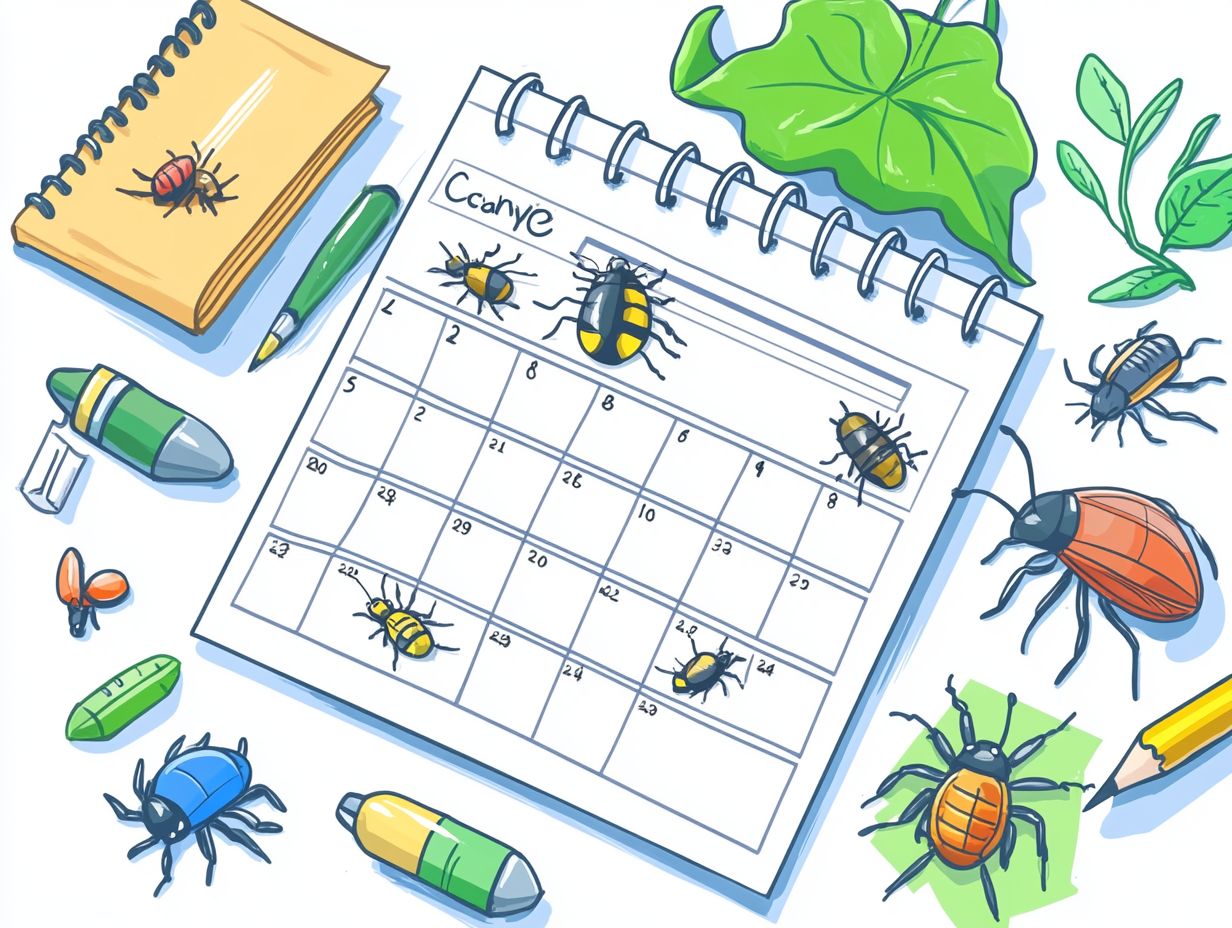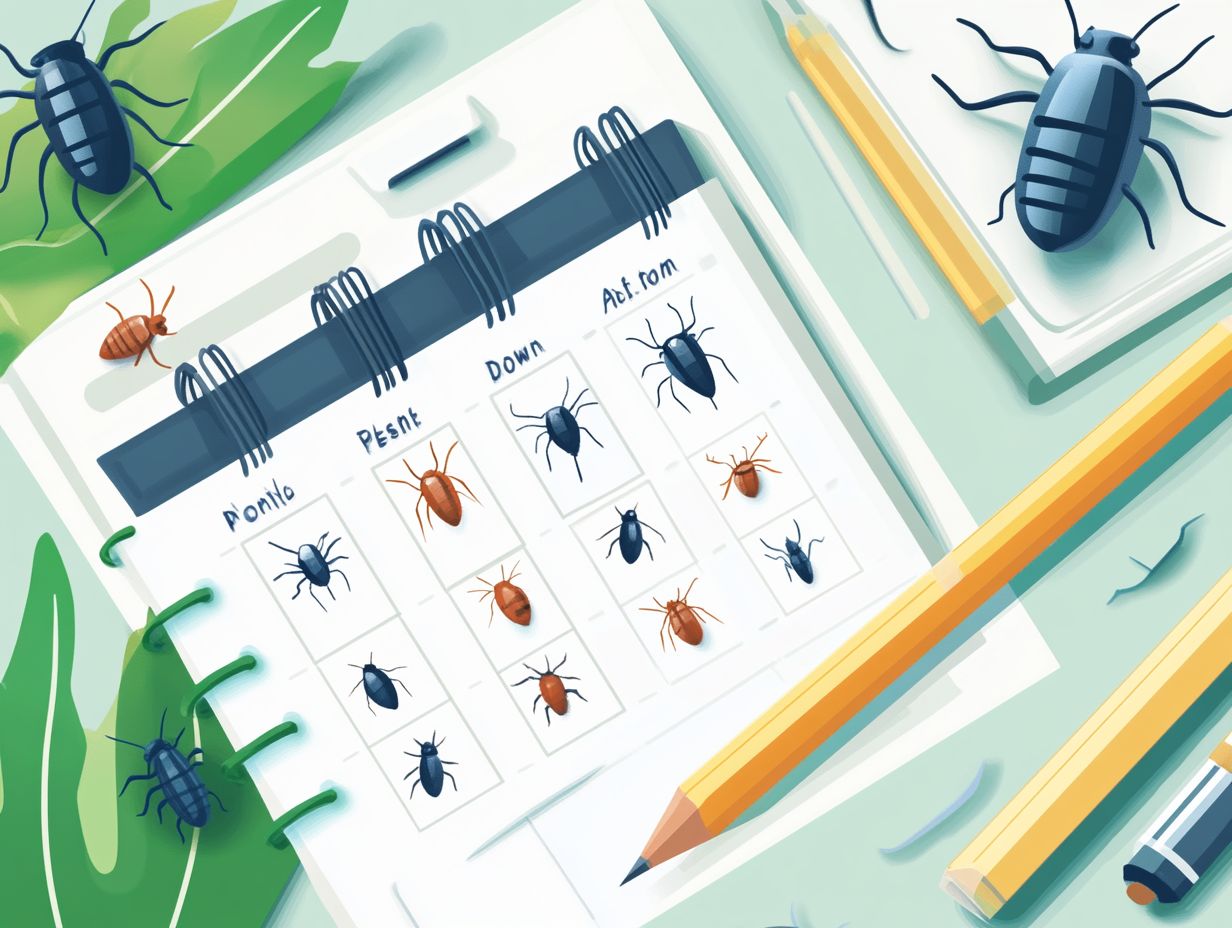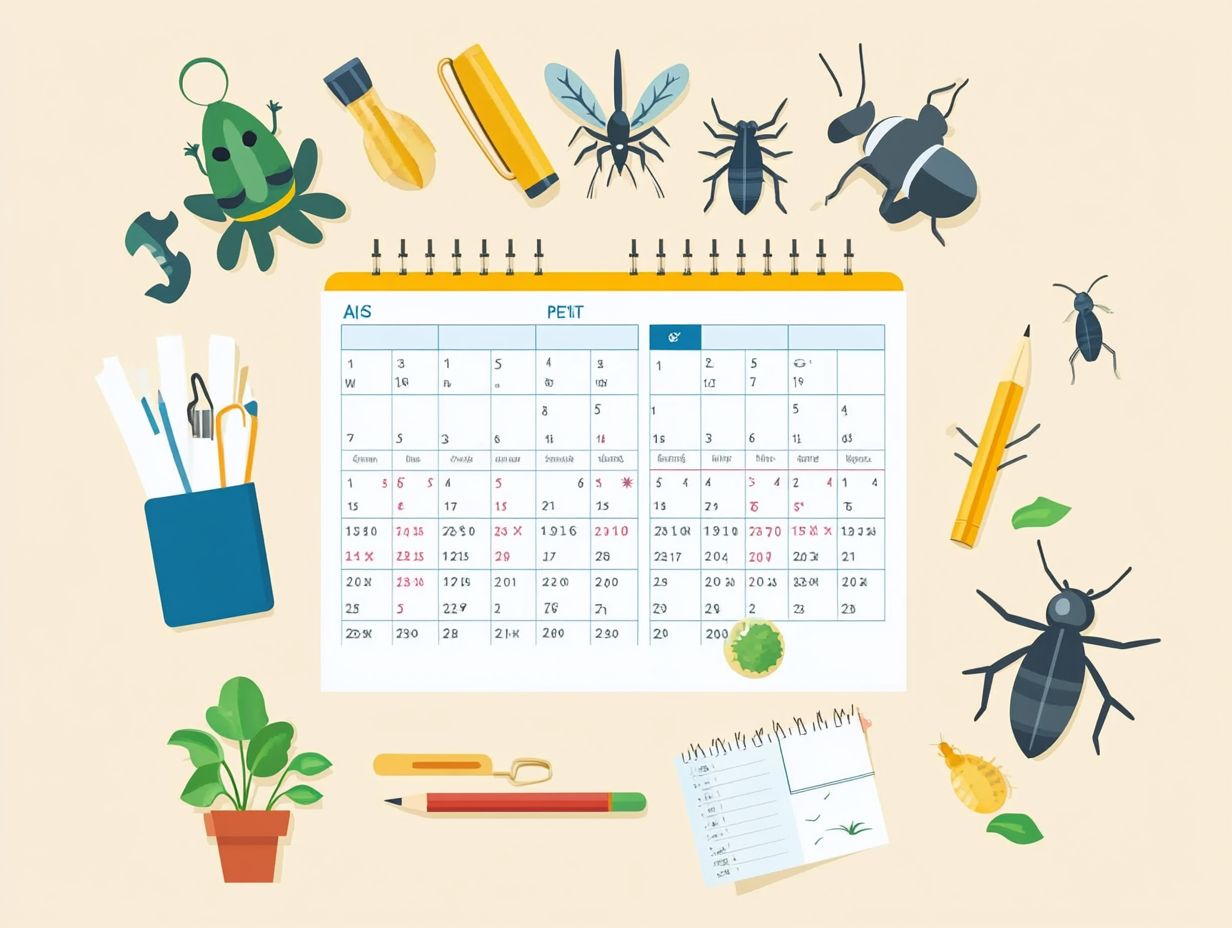How to Create a Pest Management Calendar
Managing pests effectively is essential for preserving a healthy environment, whether in your home or within agricultural settings. Utilizing an IPM calendar can enhance your pest management efforts.
A Pest Management Calendar is an invaluable tool that enables you to stay organized, strategize your pest control methods, and reduce pesticide usage.
This guide will illuminate the benefits of maintaining such a calendar, outline the steps required to create one, and provide tips for keeping it current.
By the conclusion, you ll be empowered to address pest issues with a proactive and efficient approach.
Contents
- Key Takeaways:
- Benefits of Using a Pest Management Calendar
- Steps to Create a Pest Management Calendar
- Maintaining and Updating the Calendar
- Frequently Asked Questions
- What is a pest management calendar, and why does it matter?
- How do I create a pest management calendar?
- What should I include in my pest management calendar?
- How often should I update my pest management calendar?
- Can I use organic or natural methods in my pest management calendar?
- Do I need to hire a professional for my pest management calendar?
Key Takeaways:

- A pest management calendar helps with organizing and planning pest control, reducing pesticide use, and creating a schedule and budget.
- Key steps in creating a pest management calendar include identifying pest problems, researching life cycles and control methods, and maintaining and updating the calendar.
- Record-keeping, monitoring, and adjusting for changes and new pests ensures continued effectiveness.
What is a Pest Management Calendar?
A Pest Management Calendar is your helpful partner. It enhances your ability to manage insect pests throughout the growing season for effective vegetable control.
By scheduling monitoring activities and treatments according to pest activity, both novice and seasoned gardeners can implement effective pest management strategies.
You can utilize data from trusted sources, such as Michigan State University and Enviro-weather, to customize your calendar. This ensures timely interventions that promote crop health and yield.
This structured approach not only encourages a proactive stance against potential infestations but also supports well-considered choices in pest control, ensuring you meet critical treatment windows.
Routine monitoring becomes essential. By keeping an eye on pest populations and environmental conditions, you can address emerging threats before they spiral out of control.
Tailoring the calendar to your specific local climate and pest behaviors allows you to prioritize interventions, maximizing both resource efficiency and effectiveness.
With the ability to adapt to seasonal fluctuations and integrate personalized data, the Pest Management Calendar stands out as a critical companion for nurturing vibrant gardens and farms, ultimately reinforcing sustainable agricultural practices.
Benefits of Using a Pest Management Calendar
Utilizing a Pest Management Calendar presents a wealth of benefits that not only streamline your pest management efforts but also optimize crop health and enhance team collaboration.
One of the key advantages lies in the strategic planning of interventions, ensuring that you align your actions with the treatment window for specific pests, like those that target sweet corn.
A well-organized calendar fosters collaboration among your team members especially valuable for pest control companies resulting in more effective and cohesive pest management strategies.
Organizing and Planning Pest Control
Organizing and planning pest control is essential for effective pest management, and a Pest Management Calendar is your crucial tool in this endeavor, allowing for efficient monitoring control.
This invaluable resource provides a structured approach to pest control and facilitates tracking various pest activities throughout the year.
By clearly outlining treatment schedules and monitoring timelines, you can proactively tackle potential outbreaks before they escalate.
Enhanced content planning involves identifying peak pest seasons and adjusting your strategies accordingly, which is vital for achieving success.
Team collaboration thrives when everyone has access to a centralized calendar, enabling real-time updates and revisions. Utilizing customizable pest control templates simplifies the entire process, allowing you to craft tailored plans that meet your specific needs, ensuring that every facet of pest management is handled efficiently.
Reducing Pesticide Use

Reducing pesticide use is essential in modern pest management. Using a Pest Management Calendar can significantly help achieve this goal. By closely monitoring pest activity and evaluating pest thresholds, you can identify the best times for treatment, applying pesticides only when necessary.
Methods like degree days are a way to predict when pests will appear based on temperature, allowing you to minimize chemical use while supporting healthier crop production, especially for sensitive varieties like sweet corn.
Using this calendar helps you make informed decisions based on real-time data. By tracking pest life cycles, you can identify critical intervention moments, reducing reliance on preventive sprays that may lead to resistance and environmental harm.
Utilizing degree days not only helps forecast pest populations but also ensures timely and effective interventions. This thoughtful method fosters a more sustainable way to grow crops, enhancing pest control efforts and promoting ecosystem health.
Steps to Create a Pest Management Calendar
Creating a Pest Management Calendar is an exciting way to take charge of pest challenges. Start by identifying the pest problems commonly found in your area.
Next, research the life cycles of these pests and control methods tailored to your crops. These steps help develop a comprehensive schedule and budget that aligns with the growing season, ensuring timely and effective interventions.
Identifying Pest Problems
Act quickly to identify pest problems! This is the cornerstone of effective pest management strategies, allowing you to tailor interventions based on pest activity and thresholds for all pests, including Mosquitoes and Ticks. Regular monitoring is crucial for early detection of seasonal pests, enabling proactive measures to minimize potential damage and yield loss.
Establishing clear pest thresholds helps you prioritize which pests require immediate attention. Utilizing techniques like visual inspections and trap placements for pests like Stink Bugs enhances your monitoring process. Look for signs such as droppings, chewed leaves, or webbing for insights into pest presence and behavior.
Adopting integrated pest management a strategy that combines various methods to control pests helps you recognize beneficial insects that naturally combat harmful pests. This understanding aids in developing targeted pest control measures while ensuring sustainable practices promote a healthy ecosystem.
Timely identification fosters a healthy ecosystem, keeping productivity high while minimizing harmful pesticide use.
Researching Pest Life Cycles and Control Methods
Researching pest life cycles and control methods is crucial for developing effective ways to manage pests. This is especially important for crops like sweet corn and pests such as rodents and stink bugs.
By understanding the life cycles of insect pests, you can anticipate their activity and implement timely control measures. Exploring various control methods helps you choose the best strategies tailored to your specific pest situations.
For example, knowing that aphids reproduce rapidly in the spring can prompt you to apply beneficial insects like ladybugs early. This helps keep their populations in check while considering pest control templates for effective strategies.
Employing crop rotation can disrupt the life cycles of pests like root maggots, significantly reducing their impact on future plantings. While chemical controls (using pesticides to kill pests) may sometimes be necessary for severe infestations, they can be more effective when applied during critical life stages, like targeting larvae before they mature.
By adapting these methods to address specific pest dynamics, you enhance their effectiveness and promote a healthier ecological balance within your garden ecosystem.
Creating a Schedule and Budget

Creating a schedule and budget for pest management is essential for effectively implementing your Pest Management Calendar. Utilizing ClickUp features for streamlined content planning can help you analyze treatment windows for various pests and their associated costs.
With a well-structured budget, you can prioritize interventions and allocate resources effectively throughout the growing season. This aspect is crucial, as pests like cockroaches and spiders tend to follow specific life cycles, making timing critical for successful interventions.
By recognizing when different pests, such as bed bugs, are most likely to appear, you can better align your efforts with natural controls. This reduces the need for chemical treatments and fosters a healthier environment.
A clear budget lets you focus on what matters most, ensuring that you have adequate resources available for more severe infestations. By being proactive, you mitigate potential damage to your plants and contribute to long-term ecological balance, minimizing disruption to beneficial organisms within your garden ecosystem.
Maintaining and Updating the Calendar
Maintaining and regularly updating a Pest Management Calendar is essential for ensuring its ongoing effectiveness in tackling pest threats. With diligent record-keeping, you can track pest activity, evaluate treatment efficacy, and observe seasonal variations.
By consistently updating the calendar with real-time observations and data, you adapt your methods to the shifting dynamics of pests and ever-changing environmental conditions.
Record-Keeping and Monitoring
Effective record-keeping and monitoring are vital to crafting a successful Pest Management Calendar. This offers a solid framework for tracking pest activity and evaluating the outcomes of your interventions.
By documenting pest thresholds and using degree days to predict pest activity, you can refine your strategies and anticipate outbreaks before they spiral out of control. This proactive approach sharpens your decision-making and elevates your overall pest management efforts.
Your documentation should not only include the timing of pest sightings but also the environmental conditions that may have contributed to those outbreaks. Embracing tools like logs for specific pests or digital apps can streamline this process, allowing for quick data entry and easy access.
By establishing predefined action thresholds, you enable timely interventions that prevent minor issues from turning into major infestations. The cumulative data you gather becomes an invaluable reference for future seasons, enabling you to adjust your strategies based on past experiences.
Ultimately, effective record-keeping transforms reactive pest management into a systematic approach that significantly reduces crop damage and boosts productivity.
Adjusting for Changes and New Pests
Adjusting for changes and new pests is essential for keeping your Pest Management Calendar relevant in today s ever-evolving agricultural landscape. As new pests emerge and environmental conditions shift, adapt your pest management strategies accordingly, ensuring your calendar reflects the latest information.
Being proactive in monitoring your crops for signs of pest activity is vital. Timely interventions can help stop small issues from turning into significant problems.
Jump on every chance for learning, like workshops and online resources, to stay updated on the latest research and best practices. Engaging with cooperative extension services can further enhance your strategies, offering localized insights on pest trends.
Cultivating a community of shared experiences and practices leads to a robust response to emerging threats. This significantly strengthens your overall pest management efforts.
Frequently Asked Questions

What is a pest management calendar, and why does it matter?
A pest management calendar is a schedule that outlines the necessary steps and actions to prevent and control pests throughout the year. It is important because it helps to proactively manage and reduce pest infestations, saving time and money in the long run.
How do I create a pest management calendar?
To create a pest management calendar, first identify the pest species and their life cycles that are common in your area. Then, research the recommended prevention and control methods for each pest. Lastly, develop a schedule based on the timing of the pest’s life cycle and the appropriate control methods.
What should I include in my pest management calendar?
Your pest management calendar should include the specific pest species, the recommended prevention and control methods, the timing for each method, and any necessary follow-up actions. It should also include routine inspections and maintenance tasks to prevent future infestations.
How often should I update my pest management calendar?
It is recommended to review and update your pest management calendar at least once a year, or whenever there are changes in your pest control needs. This could be due to changes in the pest population, weather conditions, or any new pest control methods available.
Can I use organic or natural methods in my pest management calendar?
Absolutely! Many organic and natural methods can be effective in pest control and can be incorporated into your pest management calendar. Just make sure to research and follow proper application techniques and timing for optimal results.
Start creating your own pest management calendar today to enjoy a healthier crop yield!
Do I need to hire a professional for my pest management calendar?
You don’t have to hire a professional for your pest management calendar. However, it can be helpful in some cases.
If you are facing a severe pest problem, a professional can offer valuable expertise. Some pest control companies provide annual pest management plans tailored just for you!






